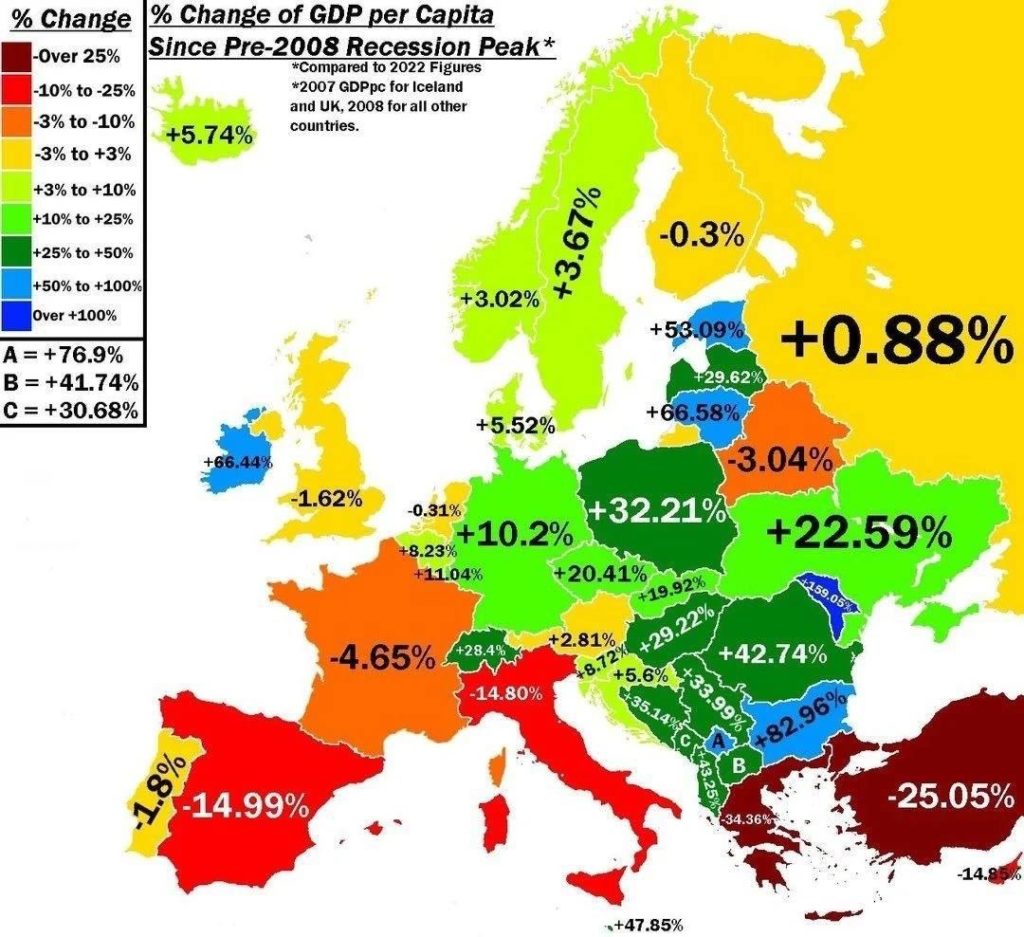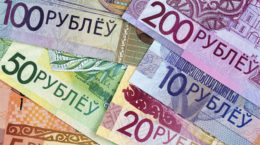Let’s speak honestly. Without hopes for 100500 billion EUR that the West will supposedly give us as soon as we get rid of Lukashenka to start a great life. Without hopes that somebody will give us the Khanty-Mansi AD when Russia collapses. Yet judging by the real state of our country and the whole region we live in.
We continue to examine different approaches which will allow to restore the growth of the Belarusian economy and give our country an opportunity to catch up with our far-advanced neighbours at an accelerated pace after Lukashenka and his “family” leave the heights of power. In the today’s article we are going to examine two issues: the benefits of joining the “Intermarium” by Belarus, and the land reform and model of the land market in the country.
“Intermarium”: Poland, Belarus and Ukraine
So, Intermarium, known to a lot of Belarusians also as “the Baltic-Black Sea Union”, is a project the Belarusian opposition has been talking about since 1991. However, in Belarus it remained only in words, while our neighbours have taken actions. The recent visit of the President of Ukraine, Volodymyr Zelensky, to Poland became iconic, indeed, not only because of the new weapons supply agreements, but also because of the elaboration of the issue of the Baltic-Black Sea region.
Actually, the issue concerns reincarnation of the geopolitical construction of the times first of Lew Sapieha, and later of hetman Vygovsky and the Treaty of Hadiach designed to elevate the Cossacks and Ruthenians to the position equal to that of Poland and Lithuania in the Polish–Lithuanian union and in fact transforming the Polish–Lithuanian Commonwealth into a Polish–Lithuanian–Ruthenian Commonwealth (“Commonwealth of Three Nations”). Over three and a half centuries later, we are now witnessing a formation of a new strategic union of two, this time sovereign, states: Poland and Ukraine. Nevertheless, a critically important component is lacking in this union, which is Belarus, as the heart of the Baltic-Black Sea Doctrine is precisely there.
Indeed, we have become witnesses how the historically biggest and the most perspective capacity development on the geopolitical axis Berlin – Moscow – Beijing is being breaking down. German business is leaving the Russian Federation and is reducing trade turnover with China before our eyes. Although, to remind, before this war, the number one trade partner for Germany was China, not the USA nor France. Nevertheless, now Germany and China will have to be satisfied with the status of being “only” the pivotal countries of Europe and Asia correspondingly. Geopolitical setups in Europe are changing in front of our eyes, and as for now it’s not too late for Belarus to participate in the process and gain a huge economic benefit.
Baltic-Black Sea region, from Finland (the country recently accepted to NATO) to Turkey (the country forming its own Organization of Turkic States), has completely chopped the Eurasian axis Berlin – Moscow – Beijing up. And that axis, by the way, could have become the Gordian knot for the USA and the UK. But no! After the war, the renewed Eastern Europe, believing in its own strengths and opportunities, is going to become a new “region of growth” in Europe, and with the course of time, a territory economically not less strong than the union of Germany, France and the Benelux countries.
Yes, the new Slavic “nucleus”, consisting of Poland, Ukraine and, hopefully, Belarus, is going to counterbalance the Old Europe in the coming years. That nucleus is 80 million people. Of course, we are speaking about positive competition, that can lead formation of multipolar European Union, not a Franco-German-centric one.
There is an old wisdom: you should communicate with people who you want to become. If you want to become an engineer, you should communicate with engineers. If you want to become a banker, you should communicate with bankers. If you want to become a poor alcoholic, you should communicate with poor alcoholics. If you want to be a successful person, your communication circle should consist of successful people.
The same thing can be applied to countries. The picture below shows how the GDP (per capita) was being restored after the crisis of the 2008 and before the 2022, when the war broke out. As we can see, the only country in the Eastern Europe to fail, was Belarus, and Russian growth was notably insignificant. On the contrary, Lithuania, Latvia, Poland, Ukraine, Moldova – all those countries were growing at an impressive rate. So, the question “who to be friends with in order to succeed?” seems to disappear by itself. It is obvious for every reasonable person, but not for the current Belarusian regime and not for its supporters.

Formation of the Intermarium with participation of Belarus, as a political and economic union, can become a real salvation for the Belarusian economy. First of all, Polish and Ukrainian sales and capital markets will open for Belarus. Second, Belarusian manufacturers will gain free access to ports: both in the Black and the Baltic Sea, and, of course, a free transit, both for its own goods and for the ones passing through Belarus from other countries. Finally, Belarus will be able to develop its own industrial projects in that union of free states of Eastern Europe, and not under sanctions, but, on the contrary, with a lot of support. That support should be similar to the one that the countries from Bulgaria and Romania to Lithuania and Latvia received when they joined the European Union.
I believe that a moment in the future will arrive, when another meeting of the leaders of Poland, Belarus and Ukraine results in signing an analog of the Élysée Treaty of 1963 between France and Germany. It was that treaty that put an end to years of enmity between those two countries and laid the foundation for future cooperation that resulted in creation of the European Union.
By the way, the key idea was to bring the people of the two countries closer together, including the youth. The emphasis was put on studying the languages of the two nations, on mutual recognition of diplomas. Thus, the Franco-German Youth Office was created, as well as French-German secondary schools, and international students’ exchange programmes were carried out. Cities and regions signed treaties of brotherhood. It is the contacts of youth of the two countries that created a basis for the strategic union of France and Germany, which are now leaders of the modern Europe. Similar basis should appear between Poland, Belarus and Ukraine.
Land and family
In general, the example of Poland is great for us. Jarosław Kaczyński and his political power “Prawo i Sprawiedliwość” (PiS) placed a bet for the productive, yet conservative part of the traditionalist society, and in the agriculture and region development policy – on small and middle farmers, the «salt of the earth”. That is why PiS is standing so strong on the ground, providing one of the greatest growth dynamics in the EU for Poland.
People elect PiS not as a joke. Poland has chosen another way, very different from that of Belarus, with Lukashenka’s mania to take everybody back to the BSSR. Belarusian agriculture is a chronically loss-making industry, while the agriculture of Poland has recently been living an unprecedented flourishing, absorbing tens of thousands of manpower, including that from Belarus (a fact unpleasant to talk about, but hard to forget for the Belarusian regime).
Article 23 of the Polish Constitution establishes the land title on the basis of family ownership, which is a dominant one. A farmer, “rolnik” in Polish, is a central subject, and the system of land relations is built around the farmer. An average farm size in Poland is up to 300 hectares; over 60% of all farms producing up to 20% of all the products of the industry fall under that category.
A special agency implements the state policy in the sphere of land relations. All plots of land are sold through an auction, and the buying farmer can pay only 20% of the selling price. The remaining sum is paid in semi-annual payments during 30 years in case a new agricultural enterprise is created with that purchase, and during 20 years in case an acting one is modernized. Average annual turnover of the land market constitutes 300-400 thousand hectares, 80% of the deals are up to 100 hectares.
The efficiency of the Polish model is demonstrated by a high capitalization level: an average price of 1 hectare is about 2000 EUR. What is the reason for success of the Polish model? For Poland, the social and cultural definition of land is dominant in the system of public relations, and thanks to that it was able to have painlessly conducted the land reform, one of the most complicated ones, eliminating any prerequisite for monopolization of the agricultural market from the very beginning.
Let’s remember that. We can build the economy of the New Belarus on the basis of any principal, but when the land is concerned, we should remember the Polish experience. In Poland, the cultural traditionalism and economic nationalism worked together for the good of the land issue. That has brough excellent results.
Our House








